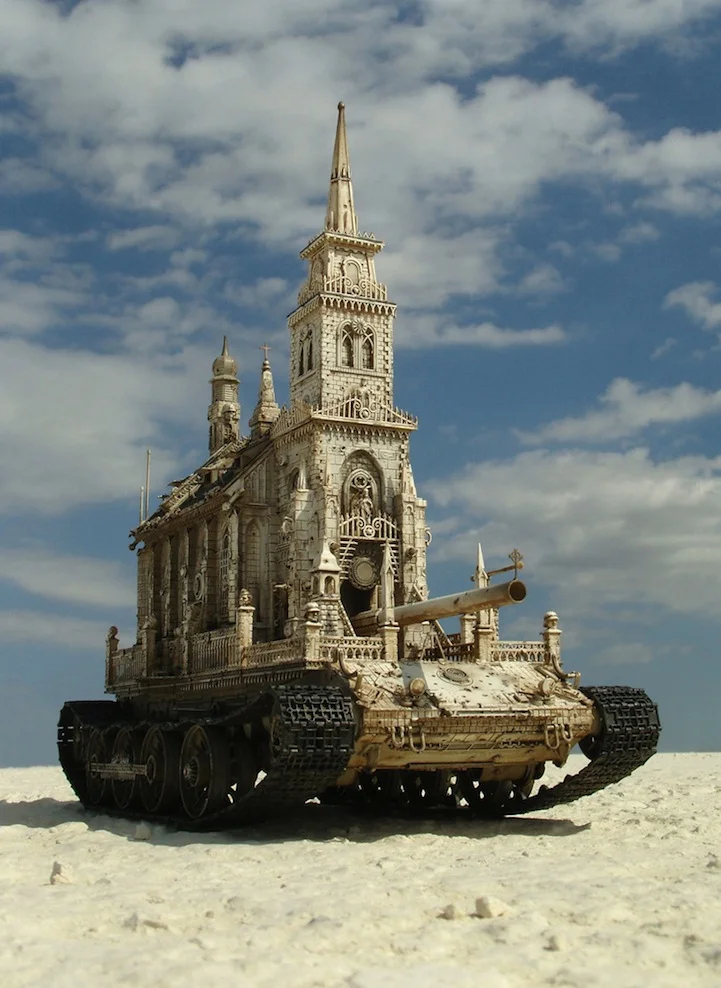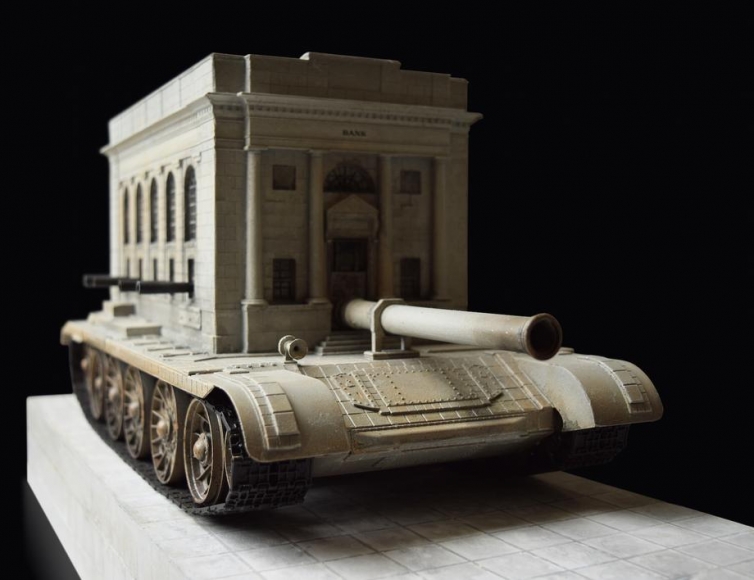Kris Kuksi depicts 'the ugly' in the most beautiful way
Kris Kuksi is truly an inspiration to artists everywhere. His success did not come to him overnight, but when it did, it certainly brought down the door with it.
As a young boy Kris grew up surrounded by rural seclusion in Kansas, Missouri, United States. While his family life was far from perfect his one salvation was his grandmother.
Kuksi: “It turns out I had a grandmother who was very generous with her time. I was baby-set by her while my mother worked.”
Kris also has two older brothers, but felt as though he was an only child while growing up. The brothers were much older and never around, he says.
He recalls that his grandmother was extremely intelligent, she taught grade school and knew a lot about American history. Rather than watching television (which they did not have), Kris listened to stories his grandmother told him and came up with his own creative ways of entertaining himself.
Kuksi: “It was natural for me to draw a lot, building with these bricks that were around because of this barn that was falling apart. I was very interested in dead animals and I guess it was just curiosity, I was drawn to the less conventional things of beauty. Which really influenced who I was. The melancholic state of childhood… What my mother was going through with my stepfather… my perception of over-sensitivity.”
While Kris does not delve deeply into the personal family issues he had to deal with as a child with his immediate family, he does mention that his stepfather was an alcoholic. The disease, is essentially the reason why his family’s dynamics growing up were extremely challenging.
In response to the circumstances, Kris found himself going more and more deeply into himself, his imagination, becoming fascinated with what is considered conventionally ugly, such as death, anything grotesque, and social taboos.
Kuksi: “You know I really loved Iron Maiden album covers, they were just beautiful to me, so I would practice, drawing, painting and you know replicating those.”
Baroque and Rococo architecture, as well as the overall aesthetic are the biggest artistic influences for Kris to this day.
He contrasts it with the “modern, cold, utilitarian world we live in today.”
Kuksi: “I think it’s a reflection of the consumer, it’s very stripped down and simple, and only for the use of commerce, rather than in itself being aesthetic. It’s very minimal there is not a whole lot of motion there or craft. It seems to be in the direction of… minimal personal touch… Which I think is interesting. I don’t despise it, I think it is fascinating.”
Kris Kuksi’s artistic style is defined as Fantastic Realism. He interprets his reality and shares his views of the human condition through sculpture, watercolour paintings, and drawings.
The most fascinating element in his work is perhaps interpretations of the taboo elements of the human condition. He likes to focus on things like war, sex, and disease, while trying to make the work aesthetically appealing.
Kuksi: “We like to think that we are more than animals, or we punish ourselves for behaving as animals, yet… history just continues to repeat itself.”
Reporter: “In what sense?”
Kuksi: “Well war is just sort of an inimical part of human nature. Our animalistic desires never seem to go away or we try to repress them and they show up in other areas. Different aspects of oppression in society have chain reactions toward deviant kinds of behaviour.”
Reporter: “Give me some specific examples?”
Kuksi: “Different class systems, levels of power, different scales of people. A form of a hierarchy, then you reduce down to subordinate people, to finally just very small, people that would signify peasants or slaves. I like to use that succession. Class systems aren’t always acknowledged. Some cultures fully embrace them.”
Reporter: “Do you feel they are embraced in the U.S.A., where you grew up?”
Kuksi: “You know I feel that it is very institutionalized, but I think it is very subtle. There is definitely class divisions between people, but there is definitely opportunity and chances to change that too.”
Kris further explains that class systems subtly force us to believe that we belong to a certain class of society and we tend to think that it is a ‘cause and effect thing’, we stay in these roles because our self-esteem does not allow us to venture further out, or ‘climb the class-system-ladder’.
There are elements outside ourselves that we cannot control, such as the family we are born into, but…
Kuksi: “We can either choose to follow along that path, or not…. Just getting to the point where you realize that you do have a conscious decision, is a big thing. The consumer world will always tell you, you are not good enough, no matter what, no matter how much money you make. You can see super wealthy people are never satisfied and always want more.”
Despite the many ideological struggles, it seems that Kris has finally found his peace back in 2007. He can vividly remember that year,; because that was the year he developed a relationship with his future wife, and subsequently had two children and a step-daughter. It was also the year his artwork truly took off.
Reporter: “When did you know that this was it, that people were finally appreciating your art and you could do this full time?”
Kuksi: “I think I realized, once galleries were fighting over my work, that’s the moment you entered this cutthroat very non-regulated industry, it was that moment when I realized that, ‘Wow this is it!’”
Like Kris says, the art-world is a cutthroat business, the bottom line is - your work has to sell. It really doesn’t matter how many degrees you may have, how hard you worked, or how long you have been an artist.
Throughout Kris Kuksi’s life he has formed the awareness of the existence of various patterns of duality within the human condition. His upbringing was of the religious nature, which made him question why the western religion for example, preached against money and power, yet fully exploited it.
He was taught virtue and goodness, yet he could see corruption within religious organizations not only through financial exploitation of the power structure of the institution itself, but also sexual exploitation of children by priests (the very anchors of such institutions), a taboo within our society that still exists today.
A way of looking to counter-balance such atrocities Kris exposes it through his art work, by depicting the ‘ugly’ in the most ‘beautiful’ way possible.
He believes that the first step to solving such a problem is by acknowledging the reality of it through his artwork.
Kuksi: “I have this popular icon called the 'Churchtanks' where I place this Church on top of a tank. It was sort of a whimsical idea I had back in 2003, didn’t think much of it, but it has become a popular symbol of my work, it kind of put my feelings in a nutshell, like people like to use religion to enforce their powerful beliefs or abuses of power…”
Reporter: “Do you practice any religion or believe in God, what is your view on this personally?”
Kuksi: “I don’t practice any religion, I think about, if there is a God that exists, but I’m just not at a point within my human body or mental capacity to really know what that is…
Is there a God?
I don’t know…
Is there some force in a universe that helps us through things?
I think so, but it doesn’t want to be known as far as I can tell, but I don’t think it’s right to obligate the people of the Earth to think that they know what it is.
It’s all a matter of experience and perspective and we can’t all share that experience or perspective.”
Kris Kuksi has an agnostic perspective, which is defined as, God or a supernatural force that is unknown or perhaps unknowable to the human kind.
His perspective on God and the duality of the human interpretation of this phenomenon is exemplified through his work, which has become so popular that the likes of Mark Parker, the Nike CEO - who bought thirteen of his installations at once - as well as musician, Fred Durst, movie director, Chris Weitz, and many other well known public figures purchase his works like hotcakes.
Kris tells me that at his most recent L.A. show his collections, which he worked for on over a year, sold within an hour.
This is the first time Kris has expanded his work from very small to very large scale. He collects various materials from all over the world and has them delivered to his studio in Kansas. Materials come from as far as Lithuania, Japan, Germany, and Ukraine.
Perhaps the best word to describe the sculptures Kris builds is ‘paradox.’
The mixed media assemblages are as varied as the sizes of his sculptures.
The incredible amount of detail he puts into his work is astounding. One gets lost in his pieces. The details meticulously sculpted and placed in asymmetrical forms. He uses plastic figures along with cold metal parts fusing it all together in an industrial yet rococo manner prevalent only to him. Kris’s sculptures are a commentary on the modern lack of morality within current governmental structures as well as institutions such as the church.
One of his best-known series of sculptures, are the ‘Churchtanks.’ The pieces are perhaps the most iconic of all his work. They exemplify perfectly, the paradox and dualism of the modern world.
His use of the baroque along with the modern industrial design pulls the viewer into the dualistic nature of the piece.
His sculptures speak to the greatest evil existing within the most holy of structures; while the actual sculpture depicting the evil structure is created in the most beautiful way possible, which in itself is a dualism resulting in a paradox. There are two opposites united within the one and the same.
While Kris is excited about how successful his work has been received in recent years, he feels tremendous pressure to create exceptional art, while balancing it with a family life. Kris and his wife are taking care of two small children, a one-year-old Owen and a three-year-old Isaac, as well as an eight-year-old step-daughter.
It seems that Kris has entered a new stage in his life where he feels content with his family and his career. He is happy to have Isaac at his studio playing with all the various pieces Kris collects to create his installations.
He still hates to finish his pieces because that means he will have to let them go, and may never see them again.
Luckily he has a great relationship with the collectors who buy many of his pieces, such as the Nike CEO, Mark Parker. Kris says he can visit them any time he wants.
The brightest of all his creations are likely his children, of whom he is the proudest.
Originally published in Belle Exotique, 2014
Photos: https://www2.ljworld.com/news/2017/nov/05/e-conquest-kris-kuksi, http://www.markmoorefineart.com/exhibitions/kris-kuksi2, https://mymodernmet.com/kris-kuksi-church-tank
By:
✘
𝓛𝓸𝓿𝓮,
𝓐𝓙☙











